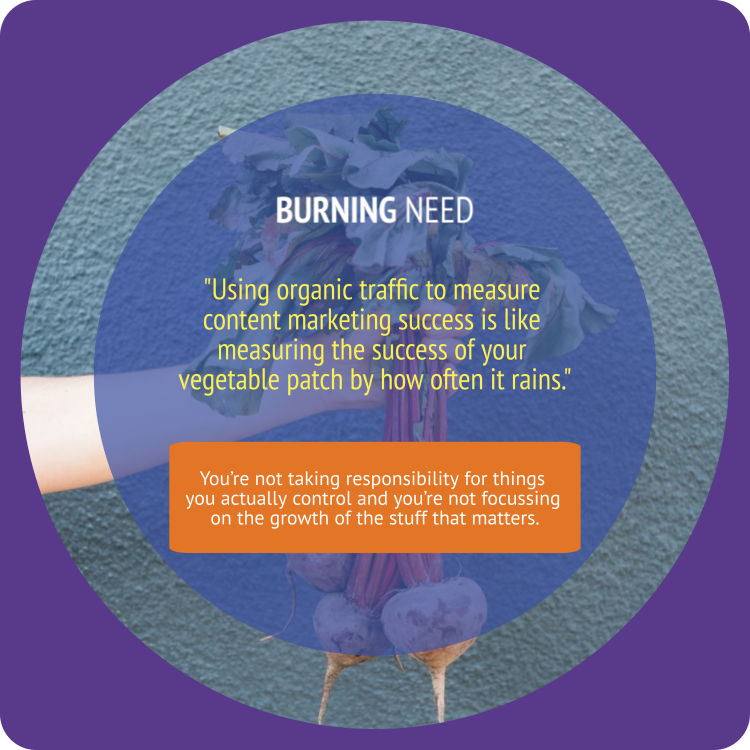Fair warning: this is not a content marketing ‘top trends’ post.
It’s a set of practical advice meant for those who know they should be looking at content marketing more seriously. From this point on, I’ll assume that’s you!
Despite years of looking at trends and thinking, ‘oooo yeh, I really must get on top of it this year’, your content marketing is still ad-hoc and getting patchy results.
Well, let’s get that fixed.
Your content in 2021:
Let’s make it the year of getting it together. No grand plans.
Let’s take simple, practical, successful steps. Lay down process. Nail the basics. Learn what works for you each step of the way.
There’s a mix of advice below. Some of it is at the strategic level, some are really simple tactical pointers. Pick and choose the items that make the most sense for you and your business.
Check out Burning Need on Adzooma Marketplace

Actually have a content marketing plan
What’s a plan that’s not written down?
I don’t know either – but it’s not a plan!
A recent survey found only 41% of B2B marketers had a documented content strategy.
But, want to know something interesting?
69% of those who considered their marketing very successful had a written plan.
On the flip side, just 16% of those who considered their strategies really unsuccessful had a written plan.

It doesn’t need to be long. It can be really simple. But it definitely needs to be written down.
At a minimum, you should understand:
- Why you’re doing content marketing in the first place (your ‘content purpose’)
- What your goals are
- Who your target audience is
- Which topics you create content for
- What your audience wants to know
- What you’re going to create and when (download my free 2021 editorial calendar template to make this really easy)
- How you’re going to promote your content
- How you’re going to measure success.
Give it a go. It’ll make you more organised, more consistent and most importantly, more successful in your efforts to win with content marketing.
Sounding a bit overwhelming? Don’t worry. I’ve put together a step-by-step guide on how to create your own content marketing plan here.

Start working in ‘content packs’
This is my favourite way to work in content marketing. It means you’re never thinking about one piece of content in isolation. Instead, you’re always thinking ‘how do I create a lead-building funnel for this topic?’.
This is important. One of the biggest mistakes businesses make in content marketing is to just blog about ideas that pop into the head of the owner.
Instead, it makes way more sense to start with a topic and a goal.
I personally like to focus on building out ONE content pack per month. Which means I’m deep diving on a single topic. Once the pack is up and running, I can always come back and add more pieces to it in the future.
The point is, it’s a ‘pack’ of content that all works together towards one goal.
Here’s how you do it:
- Start with your objective. Do you want to add prospects to your mailing list? Create leads or sales for your product? Sell a digital content bundle? Know where you want to finish before you start.
- Choose one of your major content topics that’s relevant to your objective (these should be in your content marketing plan). E.g. content marketing.
- Decide for which sub-topic you’re going to create content. E.g. ‘creating a content marketing strategy’.
- Put your reader’s hat on. What do they want to know? What do they struggle with? What do they wish they could achieve? Make a list of the questions they have in this space. To do that:
- Start with the questions you know they have
- Add to the list by checking the ‘people also search for’ section at the bottom of Google’s search results, or checking out answerthepublic.com
- Ask your audience! Find out what they want to know. Text your best customers, email your list or even ask them on LinkedIn.
- Build out keywords and check for the most in-demand questions using your SEO platform if you have one (think Moz, Semrush or Ahrefs, for example). If you don’t have one, check out the free Google plugin Keyword Surfer for keyword suggestions right in your Google Search Results pages. Use what you learn to prioritise the questions you want to answer.
- Arrange the questions you want to answer in the format of an imaginary conversation with your audience. If they sat down to chat to you, how would the conversation go? Think about it from the first question they’d ask about the topic, right through to the questions they’d ask just before they fulfilled your ultimate goal. This conversation effectively becomes your content funnel.
- Turn questions into content pieces. To do that:
- Decide if any questions should be grouped into a single piece of content
- Decide which content format would best answer these questions for your audience
- Give the content piece a draft title to help you imagine it (this will help when you write the content brief)
- Assign a call-to-action to each content piece. For example, if you’ve got an introductory blog article and a detailed ‘how-to’ guide, you might want the guide to be the call-to-action at the end of your article. This exercise links your content pieces together to form a funnel. Make sure your later pieces point towards your ultimate objective. But, only when it would make sense to your audience and their journey through the topic.
For example, here’s my content pack to which this blog article belongs:

Ask your customer stuff
How do you know what your customers want to read or watch?
Do you know what their challenges, frustrations and questions are? Do you know what they’re hoping to achieve?
Well, when was the last time you asked them?
Content Marketing Institute has a great piece about this, here. It basically says we as marketers are impatiently ‘waiting to content’ – in other words, we’re not very good at listening, but we’re very good at rushing in and saying whatever we want to say.
They also identified these top challenges we have when thinking about the audience in our market:

Notice a theme?
You could easily solve each of these challenges by talking to your audience.
In fact, they can help you to:
- Understand which content topics are most important to them
- Understand when and where you need to talk about something
- Know exactly what their questions are within a topic
- Empathise with the challenges they’re currently facing
- Envision the ultimate transformation they want to make by busting those challenges
- Prioritise what they want from a business like yours
- Make a list of places people like them are actually likely to see (or hear) your content
Worried about how you speak to them in the first place? Here are ways to have a conversation with your target audience, from least to most involved:
- Use a social listening tool like Awario to see what people are saying
- Jump into relevant forums in places like Quora or Reddit
- Run a quick poll on Twitter or LinkedIn
- Ask the question in relevant groups on LinkedIn
- Send an email out to your mailing list asking for their opinion – incentivise with a small gift or competition it if you want lots of responses
- Set up a quick coffee chat with some of your best customers for a more in-depth view
Keep it light, keep it fun. You’ll be pleasantly surprised at how willing people are to help.
Anticipate new needs
Spoiler alert: this is one of those tiresome ‘new normal’ posts you’re fed up of seeing everywhere.
I’ll make this quick!
When planning your content for the year, answer these quick questions:
- Are my customer’s needs the same as they were before coronavirus in my market?
- Do they fulfil those needs in the same way?
- Do they buy things in the same way?
- Would they use our products or services in the same way?
- Do they obtain and digest information in the same way (if they used to do all their research by chatting to people at events, there’s a definite gap to be filled)
- Are their questions the same?
If the answer to any of those questions is ‘no’, then put yourself in their shoes. How can you be as helpful to them as possible?
Guess what? This isn’t about being morose or downbeat – I promise!
We’ve always adapted to our latest situation as marketers. It’s about moving forward with the same cool, empathetic head you would have put on for any other change in your market.
Create a paid-for content piece
Hell yeah, I’m serious. Challenge yourself!
I dare you to create a content piece with the intention of charging for it.
Nothing focuses your mind to the quality of what you’re creating like the realisation that it needs to be good enough for someone to pay for it.
You’ll find yourself asking some great questions:
- How can we add as much value as possible?
- What would make them want to pay for it?
- How will it help them achieve something tangible?
It doesn’t matter how much you charge either – whether it’s £999 or £0.99.
The point is, it forces you to look at what you’re creating through the critical eye of your customer. You have to consider their journey and their experience.
See what you learn about your content, your process and your team by taking up this challenge. Pull those lessons through into your content creation process.
I guarantee it’ll make you a better content marketer!
Focus more on content promotion
76% of content marketers use organic traffic as a key metric to measuring content success. Only 22% use backlinks – Semrush
I love this statistic.
Why?
It highlights one of our main challenges as content marketers.
We love to create content. We do not love to promote our content.
The reality is this:
Content promotion is the unsexy bulk of the content marketing iceberg.
In other words, it’s what keeps a good content marketing strategy afloat.

Using organic traffic to measure content marketing success is like measuring the success of your vegetable patch by how often it rains.
You’re not taking responsibility for things you actually control and you’re not focussing on the growth of the stuff that matters.

If we focus instead on backlinks, it means we’re focusing on content promotion.
‘Which sites might promote my content?’
‘Who has a similar audience to me’?
‘How do I convince them to mention it in their blog, retweet it or even let me guest post?’
For every major content piece you create, you’ll want to put together a mini content promotion plan.
It’s essentially a checklist of all the actions you’re going to take to generate as many mentions and backlinks towards your content as possible.
This is the biggest focus of your content plan. Your content could be incredible. But if nobody sees it, it’s a total waste of your time.
Plus, getting good at this puts you ahead of 90% (probably) of the content creators in your industry.
Show your face
Pop quiz!
People connect best with:
- Heavy whitepapers
- Other people
- Labradoodles
The answer is pretty obvious…

I’d buy anything that dog put in front of me.
Sadly, unless you can teach Bailey to create ‘How-to’ videos about cybersecurity, you’re stuck doing them yourself.
Research by Gensler shows 94% of people will recommend a brand they’re emotionally engaged with.
The easiest, fastest way to connect with your audience is to show them that your brand is made up of real people. And video is the easiest way to bring people to life (until we reach Harry Potter-style photo printing, it’s just the way it is).
So the next time you’re creating content, ask yourself – could this be a straight-forward ‘talk-to-the-camera’ style video?
They cost next to nothing to make, they’re great for social and blogs alike and you can use them over and over again.
Plus, video marketers get 66% more qualified leads per year than anyone else.
Wondering how? Check out this great talking head video on how to create a great talking head video.
Summary: Get practical, aim for incremental wins and keep trying new things in 2021
If you need any content marketing advice on how to form a plan, lay down your process and nail the basics, just let us know!
I look forward to seeing what improvements you make to your content marketing efforts across 2021.




